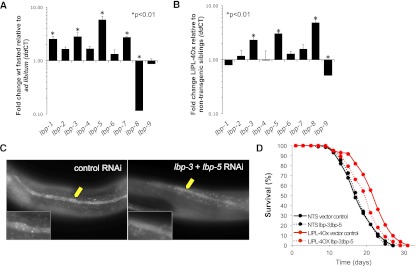Figure 5.

Lipolysis products activate autophagy in C. elegans distal from their production site with the contribution of LBPs. (A) C. elegans genes encoding the lipid transporter LBPs are transcriptionally up-regulated upon fasting. lbp-1 to lbp-9 mRNA levels of expression in 6-h-fasted wild-type young adults relative to ad libitum-fed animals of the same developmental age are depicted as mean ± SEM of three independent experiments. (B) LIPL-4Ox is sufficient to transcriptionally activate the fasting-responsive lipid transporters lbp-3, lbp-5, and lbp-8. lbp-1 to lbp-9 mRNA levels of expression in LIPL-4Ox relative to control (nontransgenic siblings) incubated at 20°C in OP50 plates are presented as mean ± SEM of three independent experiments. (C) LBP-3 and LBP-5 facilitate activation of autophagy distal from the LIPL-4 site of expression. Representative images of LGG-1∷GFP signal in intestinal and hypodermal seam cells (yellow arrow) of L3–L4 animals overexpressing LIPL-4 only in the digestive tract (vha-6 promoter), treated or not from the L4 stage of the first generation with RNAi against lbp-3 and lbp-5 (50% each), are presented. (D) LBP-3 and LBP-5 contribute to the LIPL-4 overexpression extended life span phenotype. Survival curve of LIPL-4Ox or control (nontransgenic siblings) incubated at 20°C in OP50 plates and transferred as L4 larvae to control or lbp-3/lbp-5 RNAi plates is presented. Worms were incubated at 20°C and transferred every other day to fresh control L4440 or RNAi plates until cessation of reproduction. Worms were then transferred every 7 d to maintain the strength of the treatments. Detailed statistical analysis of an independent experiment is presented in Supplemental Table S3.
